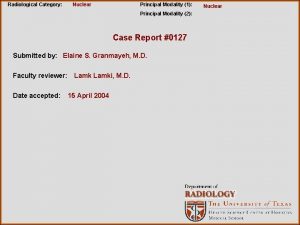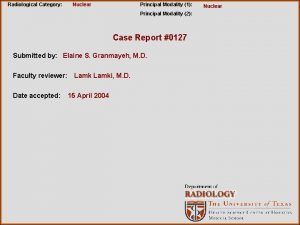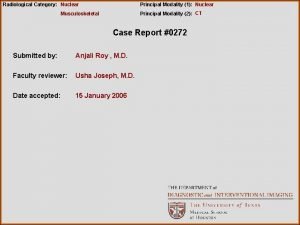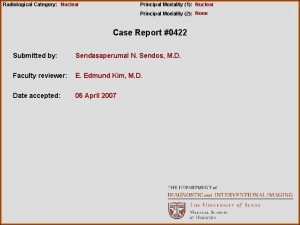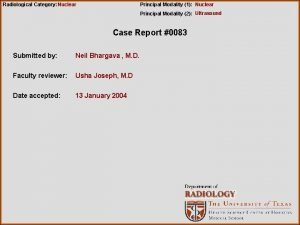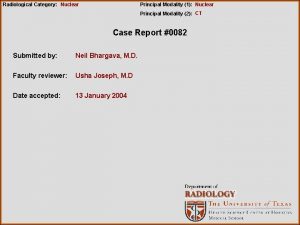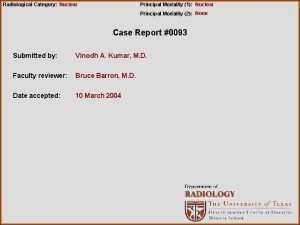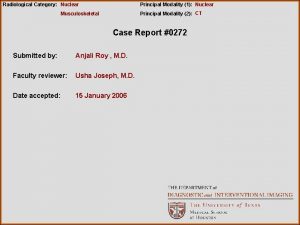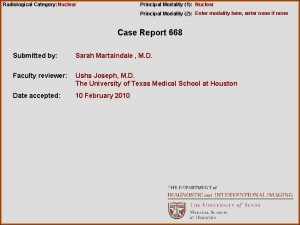Radiological Category NUCLEAR Principal Modality 1 Nuclear Principal












- Slides: 12

Radiological Category: NUCLEAR Principal Modality (1): Nuclear Principal Modality (2): None Case Report #0167 Submitted by: M. Yahya Sawaf , M. D. Faculty reviewer: Bruce Barron, M. D Date accepted: 28 November 2004

Case History Seven year- old male with history of recent lower GI bleed ( bright blood per rectum) requiring blood transfusion. Nuclear Medicine study was requested using Technetium 99 -m Pertechnetate.

Radiological Presentations Blood flow images

Radiological Presentations Function images

Radiological Presentations

Test Your Diagnosis Which one of the following is your choice for the appropriate diagnosis? After your selection, go to next page. • Normal radiotracer activity in the stomach and kidneys. • Meckel’s diverticulum. • Focal collection of radioactive tracer in the ureter. • Profuse upper gastrointestinal bleed.

Findings and Differentials Findings: Immediate anterior abdominal flow images show no focal abnormality. Dynamic images obtained for the next 30 minutes showed a focal area of increased tracer activity in the left lower abdomen just above the bladder. This focus of activity appears at the same time with the stomach activity and persists throughout the dynamic study. Static oblique views obtained after the dynamic images showed persistent activity in the mentioned focus. Differentials: • Focal areas of hyperemia such as inflammatory bowel disease or hemangiomas. • Normal transit of pertechnetate from the stomach. • Ectopic gastric mucosa in structures other than Meckel’s diverticulum. • Acute Appendicitis • Lymphoid hyperplasia • Pelvic/ectopic kidney • Dilated renal collecting system

Discussion • Meckel’s diverticulum is a remnant of the omphalomesenteric duct, which extends from the umbilicus to the antimesenteric aspect of the ileum. • It occurs in 2% of the general population. • It is located usually within two feet of the ileocecal valve. • It is symptomatic in 20% of cases. • It occurs usually in children less than 2 years of age. Approximately 75% of all symptomatic Meckel’s diverticula contain ectopic gastric mucosa. The most common presentation is gastrointestinal bleeding from peptic ulceration of the ileum adjacent to a Meckel’s diverticulum that contains gastric mucosa. Less frequently, a Meckel’s diverticulum may present with obstruction from a fibrous band connecting it to the anterior abdominal wall or from intussusception, with a Meckel’s diverticulum serving as the lead point. Some may also present with inflammation: diverticulitis. Meckel’s diverticulum scintigraphy is based on localization of the pertechnetate anion in ectopic gastric mucosa.

Discussion A normal examination demonstrates rapid accumulation in the stomach. Subsequent antegrade passage of the pertechnetate from the stomach through the duodenum and into the jejunum is often seen. There is also some excretion of pertechnetate through the urinary tract. A Meckel’s diverticulum demonstrates a focal area of pertechnetate localization, which is usually similar to the stomach in it’s time of appearance. False positive studies: 1. Incorrect identification of normal structures, particularly portions of the urinary tract. The major features that distinguish this from a Meckel’s are location and time course of visualization. 2. Focal areas of hyperemia, such as those seen in hemangioma, focal inflammation, and the uterus. Focal hyperemia should not appear very intense, and it should fade in manner similar to blood pool activity in the spleen and in the major vessels.

Discussion • Intussusception: In the absence of ectopic gastric mucosa, visualization of intussusception should simply be due to associated hyperemia, and thus tracer localization should be mild and transient. Alternatively intussusception can be caused by Meckel’s diverticulum serving as a lead point. References: Wilson, m. Textbook of Nuclear Medicine. .

Discussion TRICKS TO INSURE OPTIMAL STUDY • • H-2 BLOCKER EITHER 3 DAYS ORAL OR IV 20 MINUTES BEFORE STUDY TURN PATIENT OBLIQUELY ON LEFT SIDE, BUT IMAGE ANTERIORLY. THIS WILL KEEP STOMACH CONTENTS IN PLACE. TRY TO WAIT UNTIL CHILD CAN OR DOES VOID AND REPEATE IMAGES. GU ABNORMALITIES CAN BE EXCLUDED, USUALLY BY DOING THIS MUST GET POSTERIOR AND OBLIQUES TO LOOK AT GU SYSTEM MECKELS ACTIVITY SHOULD APPEAR AT SAME TIME AS STOMACH. IF IT APPEARS LATE IT IS USUALLY RELATED TO GU TRACK. TAKE ONE PICTURE OF CHEST TO EXCLUDE BARRETT’S ESOPHAGUS. CONSTIPATION, RECENT SCOPING OR LAXATIVES WILL CAUSE BOWEL WALL INFLAMMATION AND POTENTIALLY COULD YIELD FALSE POSITIVES. REMEMBER, A NEGATIVE STUDY DOES NOT COMPLETELY RULE OUT A MECKEL’S DIVERTICULUM

Diagnosis Meckel’s diverticulum.
 Erate pa
Erate pa Radiological dispersal device
Radiological dispersal device Tennessee division of radiological health
Tennessee division of radiological health Center for devices and radiological health
Center for devices and radiological health National radiological emergency preparedness conference
National radiological emergency preparedness conference Fisión nuclear vs fision nuclear
Fisión nuclear vs fision nuclear Lesson 15 nuclear quest nuclear reactions
Lesson 15 nuclear quest nuclear reactions Cardinality and modality
Cardinality and modality Cardinality and modality in database
Cardinality and modality in database Modality in software engineering
Modality in software engineering Diagnostics imaging
Diagnostics imaging Pacs modality workstation
Pacs modality workstation Past tense in xhosa
Past tense in xhosa













